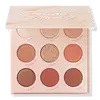What's inside
What's inside
 Key Ingredients
Key Ingredients

 Benefits
Benefits

 Concerns
Concerns

 Ingredients Side-by-side
Ingredients Side-by-side

Synthetic Fluorphlogopite
CI 77891
Cosmetic ColorantKaolin
AbrasiveMagnesium Myristate
Vinyldimethicone
Polymethylsilsesquioxane
Silica
AbrasiveEthylhexyl Palmitate
EmollientPhenyl Trimethicone
Skin ConditioningDimethicone
EmollientDiisostearyl Malate
EmollientTrimethylsiloxysilicate
EmollientLauroyl Lysine
Skin ConditioningPhenoxyethanol
PreservativeAluminum Hydroxide
EmollientTriethoxycaprylylsilane
CI 77492
Cosmetic ColorantSynthetic Fluorphlogopite, CI 77891, Kaolin, Magnesium Myristate, Vinyldimethicone, Polymethylsilsesquioxane, Silica, Ethylhexyl Palmitate, Phenyl Trimethicone, Dimethicone, Diisostearyl Malate, Trimethylsiloxysilicate, Lauroyl Lysine, Phenoxyethanol, Aluminum Hydroxide, Triethoxycaprylylsilane, CI 77492
Zinc Stearate
Cosmetic ColorantSynthetic Fluorphlogopite
Polymethylsilsesquioxane
Magnesium Stearate
Cosmetic ColorantBoron Nitride
AbsorbentDimethicone
EmollientCaprylic/Capric Triglyceride
MaskingPhenoxyethanol
PreservativeCaprylyl Glycol
EmollientEthylhexylglycerin
Skin ConditioningHexylene Glycol
EmulsifyingDimethiconol
EmollientIron Oxides
Mica
Cosmetic ColorantCI 77891
Cosmetic ColorantEthylhexyl Isononanoate
EmollientTrimethylsiloxysilicate
EmollientAlumina
AbrasiveDimethicone Crosspolymer
Emulsion StabilisingIsopropyl Myristate
EmollientCetyl Dimethicone
EmollientStearalkonium Hectorite
Gel FormingTin Oxide
AbrasivePropylene Carbonate
SolventCI 75470
Cosmetic ColorantCI 77491
Cosmetic ColorantTalc
AbrasiveLauroyl Lysine
Skin ConditioningSilica
AbrasiveCI 16035
Cosmetic ColorantCI 19140
Cosmetic ColorantCalcium Sodium Borosilicate
Magnesium Myristate
Aluminum Starch Octenylsuccinate
AbsorbentCI 42090
Cosmetic ColorantZinc Stearate, Synthetic Fluorphlogopite, Polymethylsilsesquioxane, Magnesium Stearate, Boron Nitride, Dimethicone, Caprylic/Capric Triglyceride, Phenoxyethanol, Caprylyl Glycol, Ethylhexylglycerin, Hexylene Glycol, Dimethiconol, Iron Oxides, Mica, CI 77891, Ethylhexyl Isononanoate, Trimethylsiloxysilicate, Alumina, Dimethicone Crosspolymer, Isopropyl Myristate, Cetyl Dimethicone, Stearalkonium Hectorite, Tin Oxide, Propylene Carbonate, CI 75470, CI 77491, Talc, Lauroyl Lysine, Silica, CI 16035, CI 19140, Calcium Sodium Borosilicate, Magnesium Myristate, Aluminum Starch Octenylsuccinate, CI 42090
Ingredients Explained
These ingredients are found in both products.
Ingredients higher up in an ingredient list are typically present in a larger amount.
Ci 77891 is a white pigment from Titanium dioxide. It is naturally found in minerals such as rutile and ilmenite.
It's main function is to add a white color to cosmetics. It can also be mixed with other colors to create different shades.
Ci 77891 is commonly found in sunscreens due to its ability to block UV rays.
Learn more about CI 77891Dimethicone is a type of synthetic silicone created from natural materials such as quartz.
What it does:
Dimethicone comes in different viscosities:
Depending on the viscosity, dimethicone has different properties.
Ingredients lists don't always show which type is used, so we recommend reaching out to the brand if you have questions about the viscosity.
This ingredient is unlikely to cause irritation because it does not get absorbed into skin. However, people with silicone allergies should be careful about using this ingredient.
Note: Dimethicone may contribute to pilling. This is because it is not oil or water soluble, so pilling may occur when layered with products. When mixed with heavy oils in a formula, the outcome is also quite greasy.
Learn more about DimethiconeThis ingredient comes from a fatty acid (lauric acid) and amino acid (lysine). It is used to add a silky feel to cosmetics.
According to a manufacturer, its fatty acid base leaves a silky feeling on the skin. It also has emollient properties because of this. Emollients help soften skin by preventing water from evaporating.
Lauroyl lysine is barely soluble in water.
Learn more about Lauroyl LysineWe don't have a description for Magnesium Myristate yet.
Phenoxyethanol is a preservative that has germicide, antimicrobial, and aromatic properties. Studies show that phenoxyethanol can prevent microbial growth. By itself, it has a scent that is similar to that of a rose.
It's often used in formulations along with Caprylyl Glycol to preserve the shelf life of products.
Polymethylsilsesquioxane is a silicone used as a film forming agent.
When applied to the skin, this ingredient creates an invisible film on the surface. This film still allows oxygen to pass through, but prevents moisture from escaping. This can help condition and hydrate the skin. It also leaves a silky feel when applied.
Polymethylsilsesquioxane has not been shown to clog pores. It has been deemed safe to use up to 55%, but most cosmetics use much less.
If you have concerns about using this ingredient, we recommend speaking with a professional.
Learn more about PolymethylsilsesquioxaneSilica, also known as silicon dioxide, is a naturally occurring mineral. It is used as a fine, spherical, and porous powder in cosmetics.
Though it has exfoliant properties, the function of silica varies depending on the product.
The unique structure of silica enhances the spreadability and adds smoothness, making it a great texture enhancer.
It is also used as an active carrier, emulsifier, and mattifier due to its ability to absorb excess oil.
In some products, tiny microneedles called spicules are made from silica or hydrolyzed sponge. When you rub them in, they lightly polish away dead skin layers and enhance the penetration of active ingredients.
Learn more about SilicaSynthetic Fluorphlogopite is the synthethic version of mica. It consists of fluorine, aluminum and silicate.
Synthetic Fluorphlogopite is used to add volume to products.
It is considered non-irritating on the skin.
Learn more about Synthetic FluorphlogopiteThis silicone is an emollient. Emollients create a thin film on the skin to prevent moisture from escaping.
It is not soluble in water and helps increase water-resistance in products.
According to a manufacturer, it can blend seamlessly with silicone oils, such as Cyclopentasiloxane.
Learn more about Trimethylsiloxysilicate